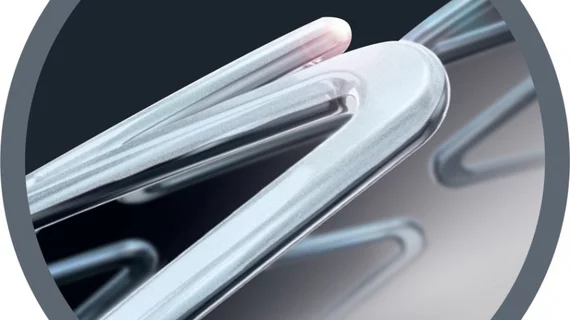Stent strut thickness after PCI: Is thinner always better?
Ultrathin drug-eluting stents (DES) performed better than their thicker counterparts in a recent analysis of the BIO-RESORT trial, researchers reported in JAMA Cardiology May 21—but thinner struts might not always be the right go-to for patients after percutaneous coronary intervention (PCI).
As cardiology practices have evolved over the past three decades, stent struts have been made progressively thinner, Rosalie A. Buiten, MD, and colleagues wrote in their JAMA study. For the most part the evolution has been a success—thinner struts discourage abnormal coronary flow after implantation and have been associated with greater flexibility and deliverability and better clinical outcomes—but it remains unclear whether ultrathin-strut DES would benefit all PCI patients or just the subset with smaller vessels.
“A lower strut thickness may be particularly advantageous in small target vessels because thicker struts and a smaller minimum in-stent lumen diameter are known to be independent predictors of restenosis in coronary stents,” Buiten et al. wrote. “This can be explained by the greater relative effect of the strut size on lumen obstruction in small vessels. Therefore, the potential clinical advantage of a reduction in strut thickness may be best reflected in the outcome of patients with small target vessels.”
Two- and three-year outcome data were of particular interest to Buiten and her team because in newer-generation DES, a significant portion of target lesion revascularization (TLR) procedures occur beyond one year of follow-up.
The BIO-RESORT study enrolled 3,514 all-comer patients with obstructive coronary disease in the Netherlands who were randomized 1:1:1 to treatment with the ultrathin-strut sirolimus-eluting Orsiro stent, very thin-strut everolimus-eluting Synergy stent or previous-generation thin-strut zotarolimus-eluting Resolute Integrity stent. All stents differed in the drug they delivered, the polymer used to deliver it and strut thickness, but while they saw similarly positive outcomes at three years, the Orsiro stent was marginally more successful in patients with smaller vessels.
Buiten et al. reported patients with coronary vessels 2.5 mm or less in diameter saw fewer repeated target lesion revascularizations with the thinnest-strutted stent compared to previous-generation devices. In an editorial, Columbia University Medical Center’s Ajay J. Kirtane, MD, SM, and Roxana Mehran, MD, said the team’s results are relevant because they support the hypothesis that the comparative contribution of stent strut thickness may be greatest among vessels that aren’t big enough to tolerate thicker-stent struts and their greater risk of intimal hyperplasia.
“As a secondary analysis of a larger randomized trial, several caveats apply, and additional data are required before broader conclusions can be made,” Kirtane and Mehran wrote, echoing Buiten and colleagues’ own conclusion that further research is needed to explore the full potential of very thin-strut stents.
While the Orsiro saw the best results in their study, Buiten and co-authors said, all three stents differed in polymer type, eluted drug and geometry, so the researchers can’t definitively say strut thickness was the main driver behind their observed results.
“Thinner may not always be better, as a randomized trial of the same thin-strutted DES studied within the BIO-RESORT trial failed to demonstrate noninferiority of this device when used to treat chronic total occlusion lesions that perhaps require a greater degree of radial strength,” Kirtane and Mehran said. “Nonetheless, the data presented by Buiten et al. lend credence to a patient-specific and lesion-specific approach to device selection that is supported through the generation of randomized clinical evidence.”

